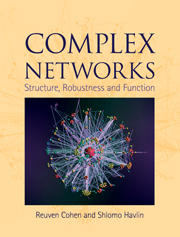Book contents
- Frontmatter
- Contents
- 1 Introduction
- PART I RANDOM NETWORK MODELS
- PART II STRUCTURE AND ROBUSTNESS OF COMPLEX NETWORKS
- PART III NETWORK FUNCTION: DYNAMICS AND APPLICATIONS
- Appendix A Probability theoretical methods
- Appendix B Asymptotics and orders of magnitude
- Appendix C Algorithms for network simulation and investigation
- References
- Index
1 - Introduction
Published online by Cambridge University Press: 05 August 2013
- Frontmatter
- Contents
- 1 Introduction
- PART I RANDOM NETWORK MODELS
- PART II STRUCTURE AND ROBUSTNESS OF COMPLEX NETWORKS
- PART III NETWORK FUNCTION: DYNAMICS AND APPLICATIONS
- Appendix A Probability theoretical methods
- Appendix B Asymptotics and orders of magnitude
- Appendix C Algorithms for network simulation and investigation
- References
- Index
Summary
Networks are present in almost every aspect of our life. The technological world surrounding us is full of networks. Communication networks consisting of telephones and cellular phones, the electrical power grid, computer communication networks, airline networks and, in particular, the world-wide Internet network are an important part of everyday life. The symbolic network of HTML pages and links – the World Wide Web (WWW) – is a virtual network that many of us use every day, and the list is long. Society is also networked. The network of friendship between individuals, working relations, or common hobbies, and the network of business relations between people and firms are examples of social and economic networks. Cities and countries are connected by road or airline networks. Epidemics spread in population networks. A great deal of interest has recently focused on biological networks representing the interactions between genes and proteins in our body. Ecological networks such as predator–prey networks are also under intensive study today. The physical world is also rich in network phenomena such as interactions between atoms in matter, between monomers in polymers, between grains in granular media, and the network of relations between similar configurations of proteins (i.e. between configurations that are in reach of each other by a simple move). Recently, studies have shown that polymer networks in real space can actually have a wide distribution of the branching factor, which is also similar to other real-world networks [ZKM+03].
- Type
- Chapter
- Information
- Complex NetworksStructure, Robustness and Function, pp. 1 - 6Publisher: Cambridge University PressPrint publication year: 2010
- 1
- Cited by

